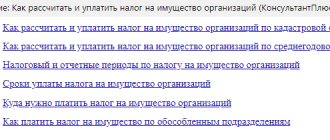Marina Pivovarova and Elena Korolev, experts from the Legal Consulting Service GARANT, talk about how an organization applying the general taxation regime takes into account property tax amounts calculated using the accrual method, as well as how to reflect the relevant information in the income tax return..
The organization applies a general taxation system; when calculating income tax, it uses the accrual method. In which accounting accounts should property tax accrual be reflected? How should property tax be reflected in tax accounting? In which line of the income tax return is this type of expense reflected?
Calculation of corporate property tax
The obligation to pay property tax lies not only with organizations on OSNO, but also with simplifiers and imputators, if the latter own real estate, the basis for calculating property tax is the cadastral value (clause 2 of Article 346.11 and clause 4 of Art. 346.26 Tax Code of the Russian Federation).
The reflection of transactions for calculating property tax in each organization depends on the adopted accounting policy. There are 2 options for recording entries in accounting:
- According to PBU 10/99 “Organization expenses”, which does not qualify property taxes as expenses for ordinary activities and, when accruing them, recommends using account 91 “Other expenses”.
- In accordance with the position of the Ministry of Finance of the Russian Federation expressed in letter dated October 5, 2005 No. 07-05-12/10, which classifies property tax as general expenses. Thus, in his opinion, tax accrual reflection is on a par with the generally accepted expenses of the organization.
Postings
The balance sheet for account 68 is used for calculations based on the results of the periods. To generate income tax amounts for the budget, subaccount 68.04.01 is used. It is important to take into account that income tax is calculated on an accrual basis. When forming it, all advance payments for the reporting periods are taken into account. This includes:
- quarter;
- half year;
- 9 months;
- calendar year.
In accordance with the chosen tax regime, an organization can independently open the necessary sub-accounts according to the types of required fees.
Account 68 postings are classified into two groups:
- by debit;
- on loan.
The following types of debit are distinguished:
- D68 K50 - the amount of fees that were taken in cash at the organization's cash desk;
- D68 K51 - the amount of funds transferred to the budget from the company’s current accounts;
- D68 K19 - value added tax, which is allocated on purchased goods, valuables, materials, aimed at reimbursement from budget funds.
Typical transactions
for a loan include:
- D70 K68.1 - a reflection of the amount of personal income tax that is withheld from the wages of the company’s employees. This amount must be paid to the budget;
- D90.3 K68.2 - the amount of funds, which reflects the amount of VAT on products sold or services performed;
- D99 K68.12 - reflects information on payment of the simplified tax system;
- D99 K68.11 - generates all accruals for UTII;
- D26 K68.8 - an accounting tool for generating amounts for payment to the budget for property;
- D90 K68.3 - display of excise taxes received by the company from the sale of excisable products;
- D99 K68.4 - the amount of income tax that is transferred to the Federal Tax Service;
Note! To reflect the amount of transport fees to be transferred to the budget, K68.7 D20.26 is used.
If property tax is assessed - posting for organizations
To prevent further disputes with inspection authorities, it would be advisable to establish in the accounting policy one of the methods for calculating property tax.
- When assigning costs to other expenses, the entry for calculating the organization’s property tax will look like this:
Dt 91 Kt 68, where:
account 91 - reflection of other income and expenses;
account 68 - property tax.
- If costs are recognized as expenses for a normal activity, the postings look like this:
- Dt 20 (23, 25, 26) Kt 68, if the activity of the enterprise is not related to trade;
- Dt 44 Kt 68 for trade organizations.
accounts 20 (23, 25, 26) - production costs;
account 44 - sales expenses.
Tax accrual is carried out quarterly, unless the reporting period is canceled by the relevant regional legislation (clause 3 of Article 379 of the Tax Code of the Russian Federation).
Each organization decides independently which method to choose. With any option for reflecting the tax enshrined in the accounting policy, an obligation to pay it will arise, which means that there will be no claims from the Federal Tax Service.
Structure of the budget accounting account
The account number has a complex structure and consists of 26 digits. Table 2 shows the composition of the account indicating the values of the digits.
table 2
| Account digit number | Meaning |
| 1–17 | Classification attribute of receipts and disposals |
| 18 | Financial support |
| 19–21 | Accounting object |
| 22 | Accounting object group |
| 23 | Type of accounting object |
| 24–26 | Type of receipts, disposals of an accounting object |
Digits 1–17 encode the classification attribute of receipts and disposals and are formed from the BCC. Budget accounting instruction No. 162n contains a separate Appendix 2, in which for each account it is specified which BCC must be indicated: the code intended for budget expenditures (KRB), budget revenues (KDB) or sources of financing the budget deficit (CIF). Moreover, for institutions, categories 4–20 of the BCC are taken, and for financial authorities, categories 1–17.
The 18th category is intended to clarify the type of financial support. For budget accounting, according to clause 2 of Order No. 162n, only the value 1 (at the expense of the budget) or 3 (at the expense of funds at temporary disposal) can appear in this place. The remaining digits directly encrypt information related to the accounting object and are indicated in the chart of accounts.
Read about drawing up a chart of accounts for budgetary accounting here.
Forms for primary documents, as well as accounting registers and reporting for public sector employees, can be found in ConsultantPlus. Get trial access to the system for free and go to the directory.
Accounting entries for property tax in 2014
For enterprises, the tax base is property, which is registered as “Fixed Assets”.
For this, accounts 01 and 03 are used, i.e. directly fixed assets and profitable investments in material assets (or assets leased).
Since the basis for calculating tax is the residual value, the data from accounts 02 “Depreciation” and 10 “Depreciation” are also taken into account.
The residual value is determined as the difference between 01 (03) and 02 accounts. For those fixed assets for which depreciation is charged, the data of the off-balance sheet 10 account is subtracted from the initial cost.
Due to the fact that the rules for determining property tax differ for different groups of fixed assets, it is recommended to take them into account in separate subaccounts.
There are four main groups of property with different tax rules:
- Real estate taxed at its residual value, in accordance with previously established standards.
- Real estate that is taxed based on cadastral value.
- Movable property objects registered before 01/01/2013.
- Movable property acquired and accounted for after January 1, 2013.
When you open a subaccount for each group, it will be much easier to calculate property taxes.
The accrual of property tax and its reflection in accounting is not regulated by law and depends on the accounting policies determined by the enterprise itself and documented.
There are several accounts to which property tax can be attributed - these are accounts 20, 23, 25, 26, 44, i.e. accounts associated with one or another group of expenses (main production, general business expenses, sales expenses, etc.)
But most often the miscellaneous expenses account (91-2) is used for correspondence. Reflecting the write-off of property taxes, entries with account 91-2 allow you to simplify accounting in the event of an error or recalculation.
The property tax accrual entry will look like this:
- Dt 91-2 Kt 68;
- When transferring the tax, the entry Dt 68 Kt 51 is made.
Property tax can be written off as expenses based on the results of accrual of advance payments, i.e. quarterly and according to the annual declaration.
No one is immune from mistakes, and often accountants at the end of the reporting period find that property taxes have been understated.
In this case, an adjustment to the property tax is made, the postings of which correspond to the income tax accounts.
Those. in case of overestimation of tax, its amount is reduced, expenses are correspondingly reduced, and the enterprise’s profit and income tax increase.
What is the tax on the sale of property that is less than 3 years old can be found in the article: tax on the sale of property.
Read about property tax under UTII here.
To account for this operation, the following entries are made:
- Dt 68, subaccount “Property tax” - Kt 91 “Other expenses”;
- Dt 99 - Kt 68, subaccount “Income Tax”.
If the income tax increases over the past period, then along with the amount of the tax, an additional penalty is charged for each period that passes after the payment deadline.
Movable property, which is considered fixed assets, was also subject to property tax until 2013 at the same rules and rates as real estate.
From January 1, 2013, all movable property registered before 2013 is excluded from taxation.
If the company acquired movable property shortly before this date, then the accountant, using the correct entries, can push back the date of registration and, accordingly, legally reduce the tax base.
First of all, it is necessary to divide the accounting of movable property (cars, equipment, furniture) into two different sub-accounts depending on the date of acquisition.
The registration date is reflected in the inventory cards for each unit. In most cases, this date coincides with the day specified in the property acceptance certificate. But there is a number of equipment that needs installation.
The registration date for such property is delayed for the period required for installation, and equipment purchased before 2013 may be registered much later.
To do this, a number of entries are made in accounting.
The initially acquired property is accounted for in account 08.1 “acquisition of movable fixed assets”
Posting Debit 08.1 Credit 07 property is transferred for installation
Upon completion of installation, i.e. After a certain period of time, the property is registered as a fixed asset by posting Debit 01.2 Credit 08.1. and from this moment property taxes are calculated.
To provide a more compelling justification for this delay, so as not to raise doubts among the inspection authorities, accounting entries should be supplemented with the issuance of orders for the transfer of equipment for installation.
Due to the ambiguous interpretation of accountants, they are most interested in the following issues related to accounting and tax accounting of property taxes.
Is the procedure for accounting for accrued amounts of property tax in the reporting period established by law?
Legislation and regulatory documents establish only the procedure for calculating, declaring and paying property taxes.
The accounting rules for this tax are determined by each enterprise individually and are enshrined in documents (orders) defining the tax policy of the enterprise.
Common to all is the possibility of writing off tax amounts for business expenses. The choice of accounts for correspondence depends on the specifics of the enterprise.
Which expenses in accounting should include the accrued amount of property tax in organizations?
The accrued property tax may be reflected as part of the enterprise's expenses and thereby form the cost of manufactured products. Each enterprise decides on its own what expenses to allocate tax amounts to.
Correspondence with other accounts
68 account is credited for the amounts indicated in tax returns. Calculations in correspondence are also taken into account here:
- 70 - amounts for personal income tax;
- 99 - accrued income tax;
- 51- receipt of overpaid fees from the budget;
- 20, 26,25,44 - local taxes.
Account 68, in turn, corresponds with the following accounts:
- 50 - cash register;
- 51 - current account;
- 52 - foreign currency account;
- 19 — value added tax;
- 10 - materials;
- 20 - main production, 21 - auxiliary;
- 41 - goods;
- 26 - general expenses on the economic line;
- 90 - sales.
Drawing up declarations
Property tax: postings
Current as of: April 13, 2021
All legal entities that pay corporate property tax. are required to pay it based on the results of the tax period, i.e. the calendar year (clause 1 of article 379. clause 1 of article 383 of the Tax Code of the Russian Federation). And if a subject of the Russian Federation has established reporting periods, then during the year it is necessary to pay advance tax payments (clause 2 of Article 383 of the Tax Code of the Russian Federation).
Of course, operations for calculating and paying property taxes must be reflected in accounting.
Results
The entry reflecting the accrual of property tax in accounting may be different depending on which of the expenses that arise for the taxpayer this tax relates to in accordance with the accounting policy adopted by him.
The frequency of calculation (quarterly or once at the end of the year) depends on whether reporting periods for this tax are established in the region. You can find more complete information on the topic in ConsultantPlus. Free trial access to the system for 2 days.
How to reflect property tax in accounting and tax accounting
In accounting, account for the accrual and payment of property taxes on account 68 “Calculations for taxes and fees.” To do this, open a sub-account “Calculations for property tax” to account 68.
Situation: which expenses in accounting should include the accrued amount of property tax?
The accounting procedure for accrued property tax amounts is not established by law. In practice, two options are used:
- inclusion of tax in other expenses (this procedure was previously provided for in paragraph 11 of the Instruction of the State Tax Service of Russia dated June 8, 1995 No. 33);
- inclusion of tax in general business expenses (this procedure is recommended in the letter of the Ministry of Finance of Russia dated March 19, 2008 No. 03-05-05-01/16).
In the first case, the accrual of property tax must be reflected by posting:
Debit 91-2 Credit 68 subaccount “Property tax payments”
Dear readers! Our articles talk about typical ways to resolve tax and legal issues, but each case is unique.
If you want to find out how to solve your particular problem, please contact the online consultant form on the left or call ext. 479 (Moscow) ext. 122. It's fast and free!
– property tax has been assessed.
In the second case, an entry should be made in accounting:
Debit 26 (44) Credit 68 subaccount “Property tax payments”
– property tax has been assessed.
Since this issue has not been resolved at present, the organization has the right to independently choose the option of accounting for property tax and enshrine it in the order on accounting policy (clauses 4, 7 of PBU 1/2008).
Attention: incorrect reflection of accrued and paid property tax in accounting is an offense (Article 106 of the Tax Code of the Russian Federation, Article 2.1 of the Code of Administrative Offenses of the Russian Federation), for which tax and administrative liability is provided.
Incorrect reflection of accrued and paid property taxes in accounting is recognized as a gross violation of the rules for keeping records of income and expenses. Responsibility for it is provided for in Article 120 of the Tax Code of the Russian Federation.
If such a violation was committed during one tax period, the inspectorate has the right to fine the organization in the amount of 10,000 rubles. If a violation is detected in different tax periods, the fine will increase to RUB 30,000.
A violation that led to an understatement of the tax base will entail a fine of 20 percent of the amount of each unpaid tax, but not less than RUB 40,000.
Dangerous moments
In practice, taxpayers often have questions regarding the inclusion of individual payments to the budget in expenses.
Land tax
Thus, the letter of the Ministry of Finance of the Russian Federation dated February 17, 2021 No. 03-03-06/1/8707 talks about land tax. It says that if, according to the current legislation on taxes and fees, an organization is recognized as a taxpayer of land tax, then the costs of paying it are taken into account when forming the tax base for income tax in the manner established by the Tax Code of the Russian Federation. Paragraph 1 of Article 388 of the Tax Code of the Russian Federation establishes that payers of land tax are organizations and individuals who own land plots recognized as an object of taxation on the right of ownership, the right of permanent (perpetual) use or the right of lifelong inheritable possession.
That is, the status of a land tax payer is determined by the presence of obligations established by the legislation of the Russian Federation. But what if the land plot is not used by the taxpayer or is used in non-income-generating activities?
Article 270 of the Tax Code does not indicate that the amounts of land tax paid on a land plot not used by the taxpayer or used in activities that do not generate income should be excluded from expenses forming taxable profit.
However, there is a dangerous point that the Ministry of Finance pointed out. Paragraph 1 of Article 252 of the Tax Code establishes that the taxpayer reduces the income received by the amount of expenses incurred, and expenses are recognized as justified and documented expenses incurred by the taxpayer.
That is, expenses can be taken into account for profit tax purposes, provided that they are documented and economically justified. Justified expenses mean economically justified expenses. Any expenses are recognized as expenses provided that they are incurred to carry out activities aimed at generating income. This means that expenses for payment of land tax paid for the period when the land plot acquired into ownership was not actually used in the economic activities of the organization are not subject to accounting as expenses that reduce the taxable base for income tax (clause 49, article 270 Tax Code of the Russian Federation). Since inspectors may assess that these expenses do not meet the criteria of paragraph 1 of Article 252 of the Tax Code of the Russian Federation.
Financiers made this conclusion earlier (see, for example, letter dated June 16, 2006 No. 03-03-04/3/12). Although in the resolutions of the Presidium of the Supreme Arbitration Court of the Russian Federation dated October 2, 2007 No. 7379/07, the Federal Antimonopoly Service of the Ural District dated September 7, 2010 No. F09-7086/10-S3, as well as in later clarifications of the same Ministry of Finance, conclusions were made in favor of taxpayers (see, for example, letter dated 04/18/2011 No. 03-03-06/2/64).
Therefore, given the ambiguous position of financiers, it is possible that disputes may arise with tax authorities, which expenses in the form of the amount of land tax on a “non-production” plot will most likely be considered as not economically justified.
Insurance premiums for payments from profits
The letter of the Ministry of Finance of Russia dated April 25, 2021 No. 03-03-06/1/23678 clarified that even if insurance premiums were accrued for employee benefits that do not reduce taxable profit, they can be taken into account as part of other expenses.
Other expenses associated with production and sales include amounts of taxes, customs duties, fees and insurance contributions to extra-budgetary funds accrued in the manner established by the legislation of the Russian Federation, except for those listed in Article 270 of the Tax Code of the Russian Federation (subclause 1, clause 1, Article 264 of the Tax Code RF).
Specifically, insurance premiums accrued for payments that are not recognized as expenses when taxing profits are not mentioned in Article 270 of the Tax Code of the Russian Federation. At the same time, this list is not closed. And the last 49 paragraphs indicate expenses that do not meet the criteria specified in paragraph 1 of Article 252 of the Tax Code of the Russian Federation.
In accordance with paragraph 1 of Article 252 of the Tax Code of the Russian Federation, for the purpose of taxing the profits of organizations, expenses are recognized as economically justified and documented expenses incurred to carry out activities aimed at generating income.
This also includes activities that are necessary for the taxpayer. It is aimed at preserving existing income, preventing a decrease in the enterprise’s property, and reducing the risk of any losses. Thus, to justify the inclusion in other expenses of insurance premiums accrued for payments not taken into account when taxing profits, the mere fact that they are not specifically named in Article 270 of the Tax Code is not enough. Therefore, in this situation, an additional criterion for confirming the validity of expenses is the necessity of these expenses for the taxpayer. Namely, the obligation to pay them in accordance with the legislation on insurance premiums and the risk of imposing penalties in connection with non-payment.
Thus, insurance contributions to extra-budgetary funds are written off as part of other expenses on the basis of subparagraph 1 of paragraph 1 of Article 264 of the Tax Code of the Russian Federation, regardless of whether the corresponding payments to employees are taken into account when taxing profits or not.
Incorrectly calculated contributions
But erroneously paid insurance premiums do not reduce taxable income. The organization imposed insurance premiums on scholarships for apprenticeship contracts, according to which employees were required to undergo training and work under an employment contract with the employer for at least three years. The amounts paid to students did not depend on qualifications, complexity, quality, or specific conditions for performing work. The inspectors did not recognize them as remuneration, excluded the wrongfully calculated insurance premiums from tax expenses and assessed additional income tax. The judges supported this position.
The court's conclusion is as follows: since the subject of the student agreement is not the performance of a labor function, the scholarship paid to a student, including an employee of an organization, is not subject to insurance contributions. Accordingly, erroneously paid insurance premiums do not reduce taxable profit (Resolution of the Moscow District Administration of June 29, 2021 No. A40-158373/2014).
Tax accounting. simplified tax system
As a general rule, simplified organizations do not pay property tax. The exception is for organizations that have real estate on their balance sheet, for which the tax base is determined as cadastral value. Property tax on these objects must be paid on a general basis (clause 2 of Article 346.11 of the Tax Code of the Russian Federation).
If an organization calculates a single tax on income, then the property tax paid will not reduce the tax base (clause 1 of Article 346.15 of the Tax Code of the Russian Federation). If an organization pays tax on the difference between income and expenses, include the amount of property tax as expenses in the period when it was transferred to the budget (subclause 22, clause 1, article 346.16, clause 2, article 346.17 of the Tax Code of the Russian Federation).
Typical wiring
The main transactions for this account are presented in the table:
| Account Dt | Kt account | Wiring Description | A document base |
| 68 | 19 | Amounts of taxes actually transferred to the budget + VAT | Payment order |
| 68 | 50/51,52,55 | Payment of tax debts in cash or through a bank | Payment order |
| 70/75 | 68 | Personal income tax withheld from the income of employees or founders | Payslip |
| Based on settlement amounts for contributions to budgets | |||
| 99 | 68 | Income tax is reflected | Help-calculation |
| 70 | 68 | We reflect the amount of accrued personal income tax | Payslip |
| 90 | 68 | We reflect VAT, excise taxes, indirect taxes | Accounting information |
| 91 | 68 | We reflect financial results (operating expenses) | Certificate of calculation/Acceptance and transfer certificate |
Example 1. Postings to subaccount 68.01 “NDFL”
Let’s say that at the end of the month, at Osen LLC, an accountant assessed personal income tax on employee salaries in the amount of 107,256 rubles. Dividends were also paid to the founders, the tax amount was 65,123 rubles.
Postings for calculating personal income tax on account 68:
| Account Dt | Kt account | Transaction amount, rub. | Wiring Description | A document base |
| 70 | 68.01 | 107 256 | Personal income tax accrued on salary | Payslip |
| 75.02 | 68.01 | 65 123 | Personal income tax accrued on dividends | Tax card for personal income tax, accounting certificate |
| 68.01 | 51 | 107 256 | Personal income tax on wages transferred to the budget | Payment order |
| 68.01 | 51 | 65 123 | Personal income tax on dividends transferred to the budget | Payment order |
Example 2. Postings to subaccount 68.02 “VAT”
At Leto LLC based on the results of the 2nd quarter (core activities):
- VAT was charged in the amount of RUB 78,958;
- VAT accepted for deduction (advance) in the previous quarter in the amount of RUB 36,695 was restored;
- VAT on the sale of fixed assets amounted to RUB 7,959.
The accountant of Leto LLC reflected the accrual of VAT with the following entries:
| Account Dt | Kt account | Transaction amount, rub. | Wiring Description | A document base |
| 90.03 | 68.02 | 78 958 | VAT charged (sales) | Accounting information |
| 76 advance | 68.02 | 36 695 | VAT restored | Sales book |
| 91.02 | 68.02 | 7 959 | VAT charged (VAT) | Certificate of acceptance and transfer |
| 68.02 | 51 | 123 612 | The tax is transferred to the budget | Payment order |
Property tax calculation: accounting entries
December 3, 2015
The formation of budgets at various levels occurs due to the state collecting part of the income of organizations and its redistribution. Tax payments of a particular business entity depend on many factors: the direction of work, the chosen mode, the availability of a calculation base, etc. For example, the calculation of property taxes and accounting entries in connection with this process must be carefully monitored. In the event of an error in calculations or correspondence, sanctions from the fiscal authorities can be significant for the business.
All mandatory payments transferred by individuals and legal entities to the state treasury are clearly regulated by relevant regulations. The Tax Code of the Russian Federation prescribes the mandatory elements of each type of contribution: rate, base, subject. Macroeconomic indicators of the state are formed on the basis of the total income received from economic entities operating on its territory. The largest revenues to budgets come from the collection of four main taxes:
— for profit (legal entities);
— property (citizens of the Russian Federation and organizations operating on its territory).
Obligations to make appropriate payments for legal entities begin from the moment they are registered as a business entity. Value added tax is included in the price of goods or services to be sold in the Russian Federation. Payments for the income received are made by all working citizens and organizations that receive it. Organizational property tax (calculation and payment) falls on all enterprises and individuals who own these objects. For organizations carrying out economic activities, the basis for paying mandatory contributions is accounting data.
How are taxes paid?
According to clauses 11, 33 of Regulation No. 640, the costs of paying taxes, the object of taxation of which is the property of the institution, are included in the amount of the subsidy provided to the autonomous institution for the implementation of the state task. In this case we are talking about corporate property tax, land and transport taxes.
The amount of tax costs included when calculating subsidies for government tasks is adjusted taking into account the coefficient of paid activities.
Thus, the costs of paying property tax, land and transport taxes can be fully or partially covered by a subsidy for the implementation of a state task. If tax costs are not fully financed by subsidies, then the autonomous institution covers the missing difference from income received from income-generating activities.
Regarding income tax and VAT, we note the following. Since the object of these taxes is income (profit) from paid activities, and not property, these taxes are paid from such income.
Property tax assessment
Postings reflecting the calculation and transfer of mandatory payments are made by all organizations that have fixed assets for production and non-production purposes. The main requirement for the emergence of an obligation is the registration and implementation of financial and economic activities of the enterprise in the territory of the Russian Federation. At the same time, it must have fixed assets on its balance sheet. The Tax Code defines a number of enterprises exempt from payment of property obligations, these include:
— institutions of the correctional system;
— federal roads, railways, pipelines, power lines;
— pharmaceutical laboratories and production;
— individual entrepreneurs applying simplified taxation regimes;
- organizers of the Paralympic and Olympic Games.
Organizations exempt at the regional level are not recognized as taxpayers. As a rule, this benefit is received by enterprises in the housing and communal services sector, agricultural, municipal, and healthcare institutions. Article No. 374 of the Tax Code of the Russian Federation contains a complete list of property tax payers.
Defining the base
Each entity carrying out any type of activity on the territory of the Russian Federation independently determines the value of the property on its balance sheet. Accordingly, it forms the basis and procedure for calculating property tax. The calculation made on the average residual value of fixed assets is considered correct.
At the same time, this value includes all analytical positions of account 01. The presence of separate divisions or branches in other regions is a factor in changing the rate or redistributing the amount between the budgets of various constituent entities of the Russian Federation. The tax base can be formed by a generalized indicator in the parent company.
Base calculation
The average annual value of the enterprise's property is calculated on the basis of balance sheet data. It is equal to the difference between the amounts recorded in account 01 and 02. Calculation of property tax in 1C and other accounting databases significantly saves the accountant’s time, since the formation of the residual value occurs automatically when the reporting period is closed. In this case, accrued depreciation is subtracted from the original price at which the fixed assets were acquired and put into operation. The residual value of all property items is summed up. The resulting value is divided by the number of months increased by one: 4 for quarterly calculations, 13 for annual calculations.
The accrual of property tax is reflected in the financial result of the enterprise, but its size directly depends on the number of pieces of equipment and its cost. The upper limit of the rate of this type of mandatory payment is prescribed in the Tax Code; it is 2.2% of the calculated base. Differentiation is allowed only within the established range and is determined by regional regulations, the category of the payer and the purpose of the property. The tax rate depends only on the place of registration of the business entity. The transferred funds go to the treasury of the corresponding region. In most cases, local authorities apply the maximum allowable value of 2.2%.
Payment deadlines
Accounting for property tax accrual is maintained throughout the entire reporting period (year). The Tax Code regulates the payment of advance payments once a quarter. The annual tax value is calculated taking into account transfers for the specified period. The deadline for filing the declaration and payment is March 30 of the year following the reporting year. When transferring advance payments, you must do so within 30 days from the end of the next quarter. At the same time, the declaration is transmitted via electronic communication channels; if the Federal Tax Service Inspectorate receives the payment on paper, it is sent 10 days before the due date. Article 383 of the Tax Code regulates the procedure for submitting information and the date. Taxpayers can use the information reflected in the main document if there are no regional regulations specifying other data.
Reflection of debit and credit on account 68
The debit of account 68 shows the amount of taxes that were actually transferred to the budget. This also includes VAT amounts that are debited from account 19.
The credit displays accrued amounts that must be transferred to the budget. All data must strictly coincide with the results of the reports submitted to the tax office.
Account credit means all amounts contributed to the budget on the basis of reports, declarations and other calculations. These include:
- profit and loss D99;
- settlements with the founders - D75;
- sales - D90;
- settlements with personnel regarding wages - D70.
Debit to account 68 includes:
- all amounts from the value added tax account for VAT;
- funds actually contributed to the budget from the current account.
To account for all amounts, entries are made: D68 K51 and D68 K19.
Display of credit and debit








